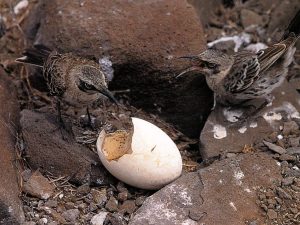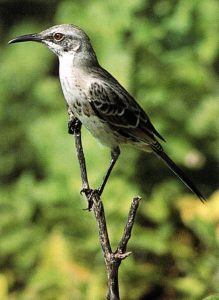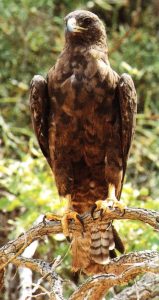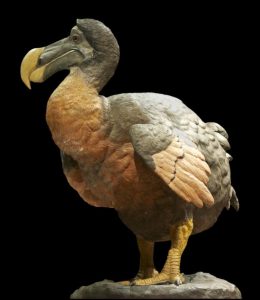My next three articles will concentrate on the birds of the Galápagos Islands. All of these birds will be endemic or subspecies endemic. The word “endemic” means that the birds are considered by experts to be restricted to the Galápagos archipelago. “Subspecies endemic” means that just a subspecies of the particular kind of bird is endemic and other similar same species birds may be found in locations outside of the islands. Whether endemic or subspecies endemic I am choosing to write about birds with unusual or unique traits. This particular article will focus on the endemic Galápagos mockingbirds and hawks.
Mockingbirds:
There are four species of mockingbird that are endemic to the Galápagos: The Galápagos Mockingbird Nesomimus parvulus, the Charles Mockingbird Nesomimus trifasciatus, the Hood Mockingbird Nesomimus macdonaldi, and the Chatham Mockingbird Nesomimus melanotis. All four of these species are generally unafraid of humans. The significance of that fact will be dealt with later in this article. Experts cannot agree on how capable these birds are so far as their ability to mimic. Evidently, there is some mimicing capability but not up to the expectations developed from human interaction with the North American mockingbirds, for example.
The Galápagos endemic mockingbirds will eat seeds, insects, other invertebrates, baby turtles, eggs, and even ticks off land iguanas. They have an upright stance with long tails and legs. Their bills are long and thin. The four species all look similar to each other with brown and grey coloration. They often prefer to run along the ground with their wings spread out for balance rather than jumping up for flight.
 Mockingbirds Eating a Boobies Egg (Horwell)
Mockingbirds Eating a Boobies Egg (Horwell)
Hawks:
The Galápagos Hawk (Buteo galapagoensis) is endemic to the islands and they too are extremely tame. Instances have been reported where these hawks have even landed on the heads of people! These birds are cream-colored as juveniles and turn dark brown as adults. They can be seen on any of the major Galápagos Islands even though it is thought there are less than 150 mated pairs living there. Females are larger than the males and are about two feet long. These hawks will eat most any living thing such as young iguanas, lizards, birds, and rats. They also eat insects and the carrion of goats, donkeys, and sea lions. These birds have no native natural enemies other than themselves.
The reproductive practice of the Galápagos Hawk is very unusual. Each female mates with up to four males. Now that might not be found to be rare in the animal kingdom, but in the case of these birds all of these males hang around to help with incubation of the eggs and raising the chicks.
What makes this most unusual is that all of the cooperative males share with both incubation and post birth assistance. This behavior is called “cooperative polyandry” and it is thought that it increases the chance of reproductive success for these birds. Evolutionists are perplexed by this behavior because it does not match up to their ideas about how natural selection is supposed to be working to improve fitness of a species. And for hawks, which are by nature usually very aggressive, why the males would join in on this type of reproductive behavior does not match the usual evolutionary presuppositions. A biblical creationist explanation might be that the Creator built this behavior into the DNA of these hawks knowing that it would be advantageous to them under certain future environmental conditions known to Him at the time of creation.
As with many birds of prey, the Galápagos Hawks are known for extremely keen eyesight. They are known to be able to see small prey from a distance away as great as the length of a football field.
No Fear of Man:
In addition to these mockingbirds and hawks, many other animals of the Galápagos have little or no fear of humans. This is of great concern to naturalists and others who are apprehensive about the extinction of these wonderful lifeforms.
Before I get into what is being done to preserve the endemic animals in the Galápagos, let’s take a look at one example where nothing was done to prevent extinction of a species. This story took place on the tropical island of Mauritius located in the Indian Ocean about 1,200 miles off the southeastern coast of East Africa and directly east of Madagascar.
Of course, I am talking about the story of the extinction of the dodo. Dodo is the common name applied to a large, flightless bird, Raphus cucullatus, which belonged to the order Columbiformes and is now extinct. The dodo inhabited the forests of Mauritius and was about the size of a turkey. The bird had a large hooked bill, underdeveloped wings and tail, and short, thick, yellow legs. It laid a single large egg in a ground nest made of grass.
The dodo was first reported in 1598 by Dutch colonizers, who characterized it as a sluggish bird unafraid of man. And that is where we see the dodo similarity to the animals that inhabit the Galápagos archipelago. In the case of the dodo within a few decades of first human contact the birds were totally extinct. The speedy extinction of the dodo is attributed in large part to domestic animals imported to Mauritius by the settlers. Animals such as hogs escaped into the woods, multiplied, and destroyed many of the dodo eggs. The fact that they were easy prey for humans contributed to their demise as well.
Enlightened by stories like that of the dodo, in 1959 the government of Ecuador, to whom the Galápagos Islands belong, declared all areas of the islands to be a National Park, excepting for those areas already colonized.
Here is a representative (not complete) listing of the park rules:
1. No plants, animals, or remains of them such as bones, pieces of wood or other natural objects should be removed or disturbed. Such actions are illegal and may cause serious harm to the island’s ecological conditions.
2. Be careful not to transport any live materials to the islands, or from island to island.
3. Do not take any food to the uninhabited islands.
4. Animals may not be touched or handled. All wild animals dislike this and will quickly lose their remarkable tameness if thus treated by human beings.
5. Animals may not be fed.
6. Do not disturb or chase any animal from its resting or nesting spot.
7. Litter of all types must be kept off the islands. Disposal at sea must be limited to certain types of garbage, only to be thrown overboard in selected areas.
8. Do not buy souvenirs or objects made from plants or animals of the islands.
These and other precautions seem to be working well so far to preserve the unique ecology of the islands and the tameness of the animals. But how can the tameness of these animals be explained? After the Global Flood God said to Noah, the fear and dread of you will fall on all the beasts of the earth, and on all the birds of the sky, on every creature that moves along the ground, and on all the fish in the sea: they are given into your hands. (Genesis 9:2 NIV.)
Could it be that this fear of man was not a learned behavior but was genetically programmed into these animals? In that case if a population of animals loses the genes for this “fear” behavior, then when separated from the main population that still has the initial genetic makeup, the separated population would have to relearn it in order to express it. The unique fearless populations of animals that arrived at the Galápagos Islands can be assumed to have landed before the arrival of any humans and would not have been afraid of them, at least not at first.
At any rate we see that the Galápagos animals are an amazing exception that really showcases the rule since most animals wherever they are located in the world still naturally fear humans.
J.D. Mitchell
Related Articles:





